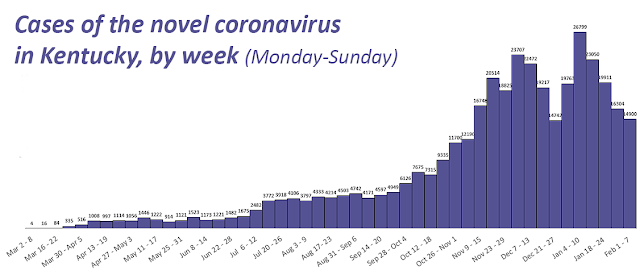As key metrics fall for 4th week in a row, Beshear says Ky. is still ‘hot’ due to strategy that kept hospitals from being overwhelmed

State Dept. for Public Health graph, adapted by Kentucky Health News; to enlarge, click on it.
—–
“The trends are all moving in the right direction, and that only happens from your hard work,” Gov. Andy Beshear said at a news conference. “We have more people wearing masks, we have more people social distancing, we’re having fewer large gatherings at homes or out in public; we must keep this up because we do not want to lose this progress.”
“If we continue on this trend, that’s something that we hope to be able to do,” he said. “Think about two different levels, the vaccine numbers going up and the cases going down, and if that continues to happen, then yes, we hope to do that.”
“So we’re burning off a little slower than other places did because we prevented that massive spike that would have overwhelmed our health-care system,” he said. “That’s at least what we think it is. Obviously, we’re humbled and knowing that there are things we don’t know about the virus, and it may take time for us to be able to look back and tell.”
Kentucky has 1,163 people hospitalized with Covid-19, the lowest since Nov. 9; 274 are in intensive care, the fewest since Nov. 3; and 142 of those are on ventilators, just two more than yesterday.
 |
| State Dept. for Public Health graph, relabeled by Ky. Health News; to enlarge, click on it. |
 |
| Holladay with grandchildren |
Memorial: Beshear honored the life of Roy “Doc” Holladay of Paducah, who died of Covid-19 at age 73. He is survived by his wife of 52 years, Martha Holladay; his daughter Heather and her husband Jim, who are friends of Beshear. He said Holladay was a master electrician who loved the outdoors and served in Germany with the Air Force.
“We’re thinking about this entire family, their loss, a loss in the community, and realizing that their grief is felt by more than four thousand families out there,” he said, noting the statewide death toll. “But we all grieve with you and care about you. And we’ll continue to do the best we can to make sure we don’t lose any other Doc’s because everybody is special and everybody is irreplaceable.”
- The 40 fatalities were five Barren County women, 68, 70, 71, 82 and 82; two Barren County men, 55 and 73; a Boyd County woman, 76; three Butler County men, 70, 78 and 83; an Edmonson County woman, 68; a Fulton County man, 75; a Graves County woman, 94; a Hardin County woman, 44; a Hardin County man, 59; a Harrison County man, 63; two Hart County women, 69 and 94; a Hart County man, 82; a Hopkins County woman, 63; a LaRue County woman, 80; a Laurel County woman, 61; a Logan County woman, 73; a Marshall County woman, 69; a Meade County woman, 75; a Meade County man, 67; four Metcalfe County men, 63, 69, 71 and 78; a Russell County man, 77; a Scott County man, 49; a Simpson County woman, 68; two Simpson County men, 58 and 70; a Warren County woman, 68; two Warren County men, 69 and 85; and a Washington County man, 66.
- Counties with 10 or more new cases were Jefferson, 205; Fayette, 69; Warren, 38; Campbell, 30; Bullitt, 26; Kenton and Madison, 25; Boone, Daviess and Shelby, 24; Graves and McCracken, 20; Allen and Hardin, 18; Franklin and Oldham, 17; Marion and Marshall, 15; Calloway, 14; Barren, Boyd, Greenup, Livingston and Pike, 13; Floyd, Nelson and Whitley, 12; Bourbon, Jessamine and Trigg, 10.
- Two hospital-readiness regions have 80% or more of their ICU beds filled: the northeast region, at 81%; and Lake Cumberland, which has been running near full capacity, at 80%.
- In long-term care, 332 residents and 235 staff have an active case of the virus, with 19 new residents and 20 new staff testing positive for the virus today. Beshear said 10 more deaths can be attributed to Covid-19, bringing the total number of deaths in these facilities to 2,193
- WDRB tells the story of how Louisville nurses are working to build trust for the coronavirus vaccine among Black communities in Louisville and in a separate story about the urgent call for a mass vaccination site in west Louisville.